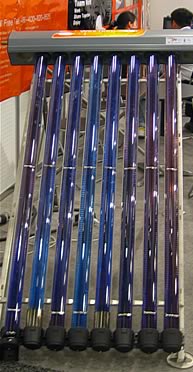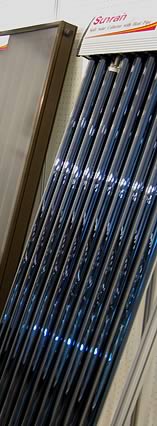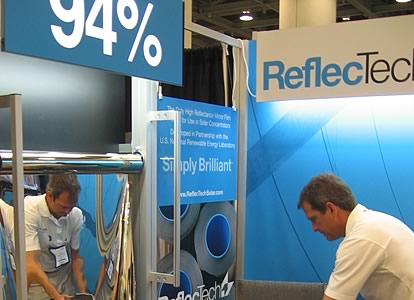July 14-16, San Francisco
InterSolar played a very prominent role this year as part of Semicom West, with three complete floors of the Moscone West Hall dedicated to solar energy displays. There were countless variations of photovoltaic solar panels from manufacturers around the world, with a strong showing of manufacturers from Germany and China. The growing photovoltaic field appears increasingly crowded, with many companies struggling to stay afloat amidst a depressed global economy and a sudden halt to PV demand from Spain due to abrupt policy corrections, closing a market which had previously been booming. Solar PV has been on a bit of a roller coaster ride with the market crash, installation slump, and drop in PV prices, so we may expect a shakeout of the weaker companies. Optisolar recently went bust and was acquired by EPOD Solar (Allora).

Also worth noting were the far sparser group of companies promoting solar thermal products, including both the well established flat panel solar thermal collectors as well as the more recent evacuated tubes. The solar thermal market may prove to have tremendous growth potential both for product sales as well as for those installation companies servicing homes and businesses.
 At Intersolar, there were a variety of talks and panel discussions on all things solar, but the focus of this article were the presentations and panel discussions on solar thermal energy which provided interesting overviews of the current state of solar thermal development as well as future projections and opportunities. Some notes from these talks follow:
At Intersolar, there were a variety of talks and panel discussions on all things solar, but the focus of this article were the presentations and panel discussions on solar thermal energy which provided interesting overviews of the current state of solar thermal development as well as future projections and opportunities. Some notes from these talks follow:
Germany clearly has a strong experiential and technological lead over the United States in small scale solar thermal, while China, the world’s largest consumer of solar thermal energy (primary roof top hot water heaters), produces flat panel collectors and evacuated tubes at considerably lower cost. Paradoxically, despite producing large quantities of photovoltaic solar panels, Chinese internal use of PV to date remains very low.
One panel discussed the counter-intuitive notion of solar thermal cooling which uses heat to drive an evaporative chiller. Solar thermal cooling has one tremendous benefit over solar thermal heating – the seasonal demand for cooling coincides perfectly with the seasonal availability of sunlight. There is plenty of sunlight on hot summer days. Evaporative chiller refrigeration been around for decades utilizing other heat sources, but solar collector technological improvements – such as evacuated solar thermal tubes – have now made large scale solar thermal cooling devices possible. Still, retrofitting existing buildings involves solving unique case by case engineering challenges – so expect some ramp up time before solar thermal cooling can be implemented to scale. While  Solar cooling could alternatively be accomplished using the electrical energy created by photovoltaics to drive air conditioners, the higher cost of the PV panels vs. solar thermal collectors, in addition to the inefficiencies of multiple energy conversions, clearly point to the advantages of solar thermal. In addition there is the energy payback time. For photovoltaics, it can take years to recapture the energy used to create the panels – purifying silicon consumes a good deal of energy. Evacuated tubes made of simple materials like glass and copper require a much smaller up front energy investment. While excess electricity from PV panels can be saved in batteries or returned to the grid, excess heat from solar thermal is harder to save. Bulky solutions akin to enormous water heaters were mentioned, heat pumps to store the summer heat into the ground for later use, and the elusive state change chemical storage were all discussed.
Solar cooling could alternatively be accomplished using the electrical energy created by photovoltaics to drive air conditioners, the higher cost of the PV panels vs. solar thermal collectors, in addition to the inefficiencies of multiple energy conversions, clearly point to the advantages of solar thermal. In addition there is the energy payback time. For photovoltaics, it can take years to recapture the energy used to create the panels – purifying silicon consumes a good deal of energy. Evacuated tubes made of simple materials like glass and copper require a much smaller up front energy investment. While excess electricity from PV panels can be saved in batteries or returned to the grid, excess heat from solar thermal is harder to save. Bulky solutions akin to enormous water heaters were mentioned, heat pumps to store the summer heat into the ground for later use, and the elusive state change chemical storage were all discussed.
Copper, a metal with excellent heat transfer characteristics, poses a limit to full global scale deployment for most solar thermal designs – there will simply not be enough copper available on the Earth. However, ideas were presented by John Rekstad of Oslo University for solar thermal flat panels made primarily of special polymers so expect other solutions looking forward.
Gerhard Stryi-Hipp, the chairman of the European Solar Thermal Technology Platform (ESTTP) posed the question: “How can fossil and nuclear power be replaced by renewable sources?’. He reports that approximately 50% of the energy used in Europe and a similar percentage in the United States is used for heating and cooling structures. To address this need, he says “solar thermal has the biggest potential under all the renewable energy sources”. The vision of the European Solar Energy Platform for Heating and Cooling is that by the year 2030:
- 100% solar heated buildings will be the building standard, and many existing buildings can be refurbished to 50% solar heating and cooling.
- 40% reduction in demand due to efficiency improvements, with solar thermal addressing much of the remaining need.
Meeting these goals will require a dramatic increase from the 13GWth currently installed up to 2400 GWth by 2030. By 2020 the goal is 80 GWth, requiring a 34% annual market grown, with a target of one square meter of solar thermal collectors for each inhabitant in Europe.

ReflecTec – thin flexible lightweight reflective foil boasting 94% reflectivity.
Reflective surfaces can be used on parabolic dish and trough concentrators.
In the United States, there are still several limitation to expanding small scale solar thermal deployment – lack of trained installation technicians, low public awareness, and inconsistent availability geographically of collectors. Photovoltaics are already well known and increasingly accepted, and in most cases they integrate easily into existing infrastructure. Solar thermal collectors, while cheaper than PV panels, require plumbing know-how to install. The two technologies are in fact complimentary, many structures in Europe already have both working simultaneously.
Article by James George


 At Intersolar, there were a variety of talks and panel discussions on all things solar, but the focus of this article were the presentations and panel discussions on solar thermal energy which provided interesting overviews of the current state of solar thermal development as well as future projections and opportunities. Some notes from these talks follow:
At Intersolar, there were a variety of talks and panel discussions on all things solar, but the focus of this article were the presentations and panel discussions on solar thermal energy which provided interesting overviews of the current state of solar thermal development as well as future projections and opportunities. Some notes from these talks follow: Solar cooling could alternatively be accomplished using the electrical energy created by photovoltaics to drive air conditioners, the higher cost of the PV panels vs. solar thermal collectors, in addition to the inefficiencies of multiple energy conversions, clearly point to the advantages of solar thermal. In addition there is the energy payback time. For photovoltaics, it can take years to recapture the energy used to create the panels – purifying silicon consumes a good deal of energy. Evacuated tubes made of simple materials like glass and copper require a much smaller up front energy investment. While excess electricity from PV panels can be saved in batteries or returned to the grid, excess heat from solar thermal is harder to save. Bulky solutions akin to enormous water heaters were mentioned, heat pumps to store the summer heat into the ground for later use, and the elusive state change chemical storage were all discussed.
Solar cooling could alternatively be accomplished using the electrical energy created by photovoltaics to drive air conditioners, the higher cost of the PV panels vs. solar thermal collectors, in addition to the inefficiencies of multiple energy conversions, clearly point to the advantages of solar thermal. In addition there is the energy payback time. For photovoltaics, it can take years to recapture the energy used to create the panels – purifying silicon consumes a good deal of energy. Evacuated tubes made of simple materials like glass and copper require a much smaller up front energy investment. While excess electricity from PV panels can be saved in batteries or returned to the grid, excess heat from solar thermal is harder to save. Bulky solutions akin to enormous water heaters were mentioned, heat pumps to store the summer heat into the ground for later use, and the elusive state change chemical storage were all discussed.